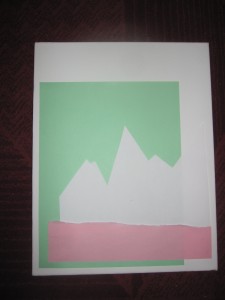Minimalist Ta’ziyeh
March 25th, 2012
My third response was inspired by the Ta’ziyeh of Iran. I was intrigued by the symbolism that pervades the passion plays, particularly that of structure and color. I particularly liked the idea that the plays don’t need to depend on complex sets, costumes, or production, since the story is capable of standing on its own. In addition, the emotional response that this simple symbolism can provoke is striking: the Ta’ziyeh in many ways represent pure, stripped-down emotion.
I wanted to mimic the evocative nature of the plays in a piece of artwork, and decided to do so in a minimalist way, depending on form and color rather than creating a piece of representational art. The colors were chosen to correspond with the colors that usually appear in Ta’ziyeh: green and white for the protagonists’ colors and red for the villains. The white background is meant to represent the sense of martyrdom that underlies the story, which is central to both Ta’ziyeh and Shia Islam, since white is considered to be the color of death in Islam. The large green rectangle represents the sense of faith that is responsible for the martyrdom, since green is often used to represent Islam. The jagged white shape symbolizes the violent deaths that occur in the story, while the rough red shape at its base represents the blood that was spilled as well as the undercurrent of ill-intent that pervades. The piece as a whole is supposed to evoke a mountain landscape, the setting of Hussein’s final confrontation with Yazid.
